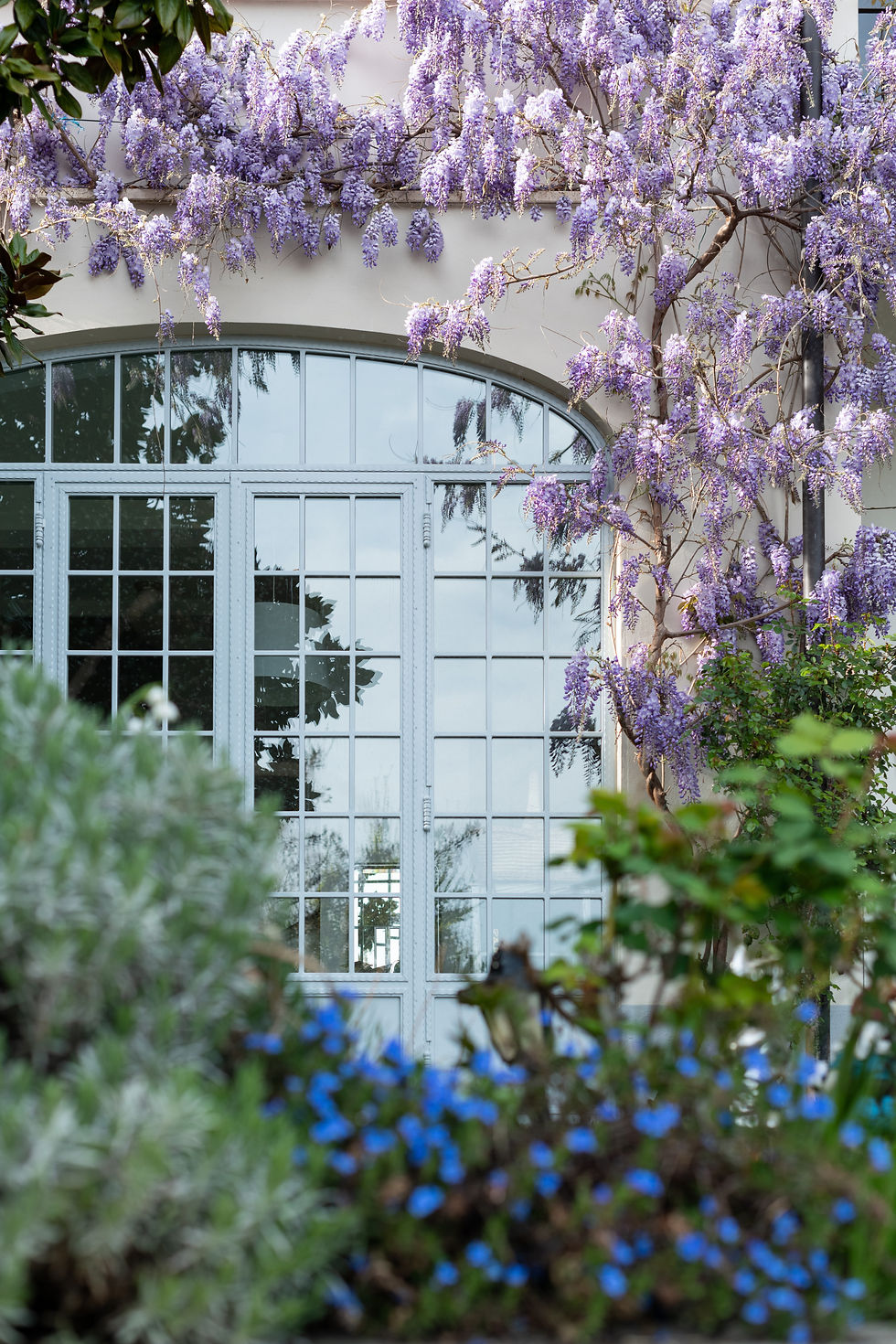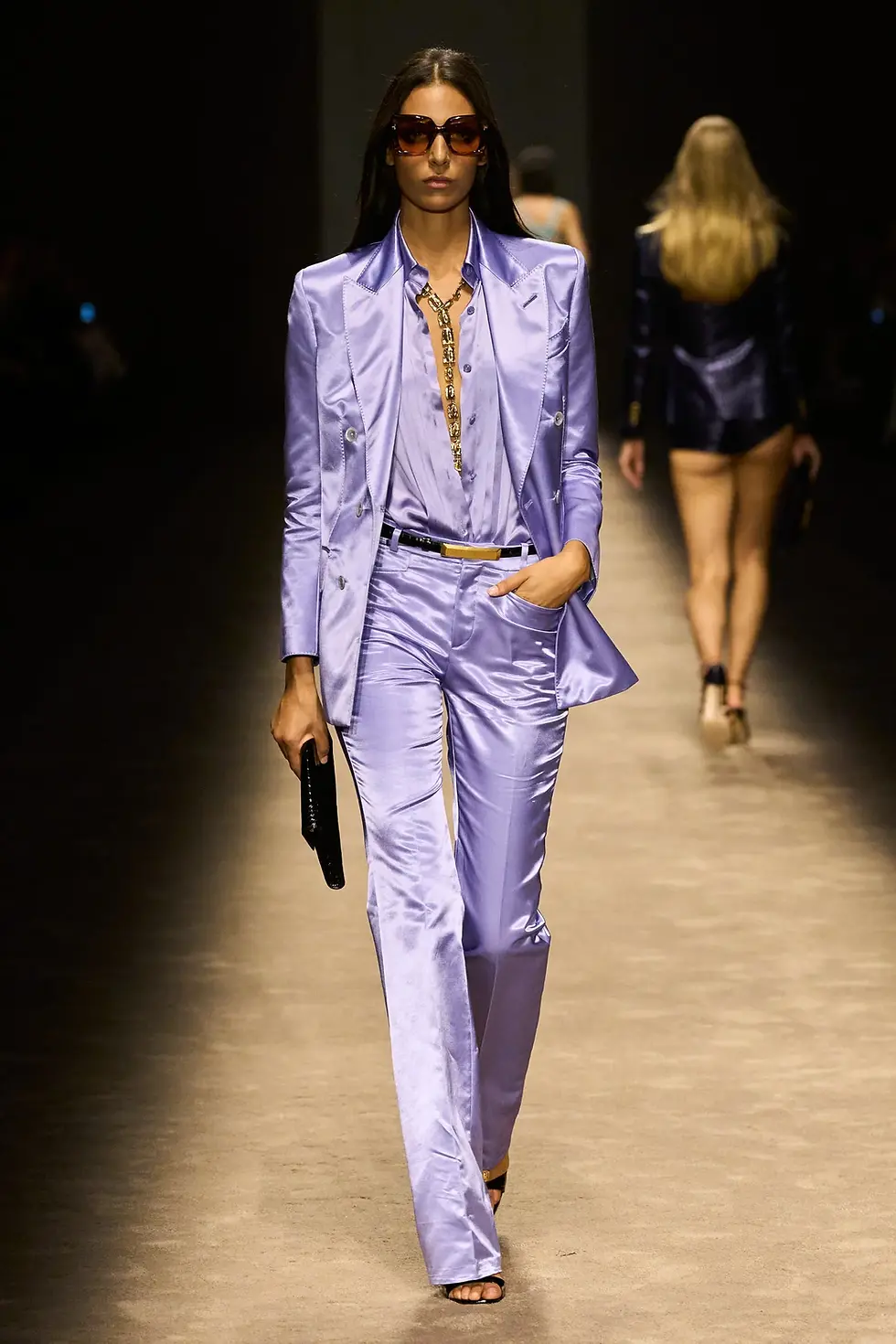WISTERIA: A SPRING COLOR STORY
- nina60688
- Apr 22, 2024
- 4 min read

Wisteria blooms have inspired artists and designers throughout history. The soft shades ranging from pale lavender to deep violet evoke a sense of tranquility and elegance. Renowned for its calming effect, it can be ideal for spaces intended for relaxation and unwinding.
In both interiors and fashion, the color is having a major moment. Offering a soft palette that appeals to both designers and consumers; wisteria-inspired hues are being incorporated into furniture, fabrics, clothing, and accessories. I don't have a natural inclination towards purple tones; but I think this subtle version will be a nice alternative to pale gray.

The color history of wisteria is closely tied to the botanical origins of the flower itself. A climbing vine known for its stunning clusters of bluish-purple flowers; the color of the blooms has inspired artists and color palettes for centuries.
The name "wisteria" itself honors the American horticulturist Caspar Wistar, but the plant's origins and history predate its introduction to the West.
The Wisteria plant is native to East Asia and the light purple hues have been used in traditional Asian art and textiles, influencing color choices in both decorative and fine arts. The flower has deep cultural significance and in Japan it is known as "fuji" and is associated with beauty, grace, and endurance. It is popular in traditional art forms like woodblock prints and paintings.

Wisteria became popular in Western gardens and art during the late 19th and early 20th centuries, particularly in the context of Japonism – the Western fascination with Japanese art and aesthetics.
Claude Monet and Vincent van Gogh were drawn to wisteria's delicate beauty, incorporating its colors into their paintings.

The color carries symbolic meanings in Western culture as well. In color psychology, purple shades like those of wisteria are associated with royalty, luxury, and spirituality.
The pastel tones call to mind a sense of calm and serenity and are often used to create soothing and harmonious color schemes in home decor, fashion collections, and branding.

On the runways this season, tones of Wisteria were a prominent theme. Many designers turned to its lighter shades to create a romantic and ethereal look, perfect for spring and summer collections. The dreamy hues were popular in evening wear with cocktail dresses and formal gowns seen in shades of lavender and mauve.
Whether you prefer subtle pastels or deeper purples, incorporating wisteria into your wardrobe delivers a soft elegance. Flowing dresses lend a sense of femininity while accessories complement both neutral and pastel colors, offering versatility in styling.
I actually like wisteria best when used as a pretty pop to a monochromatic outfit. Think a white blouse and white pants accented with a wisteria belt or purse. For a soft and sweet look, pair it with other pastels like buttery yellow, pale pink or mint green.

Since Wisteria's color is a blend of pale purple and gray-ish blue; its variation makes it a distinctive hue. It is a star in design applications because of its gentle undertones.
Evoking a sense of serenity, wisteria is renowned for its calming effect making it ideal for spaces intended for relaxation and unwinding. Perfect for bedrooms, bath rooms, or a chic study, notes of wisteria foster a tranquil atmosphere conducive to rest and rejuvenation.


Wisteria pairs beautifully with a range of colors in design. It really sings alongside soft greens like mint or sage providing a refreshing contrast that also imitates the flower as found in nature. On the other hand it delivers a chic and sophisticated vibe when used with neutrals like serene grays, creams, and whites. For a a luxe look, partner varying tones of wisteria with metallic accents like satin brass or bronze details.

Introducing elements of wisteria is surprisingly simple given its versatility. If you are looking to transform a room, painting the walls in a wisteria tone will instantly elevate the space and create a true sense of ambiance and an airy feel.
In a neutral room, introducing wisteria through soft furnishings will infuse a space with a touch of elegance. Pair this with a few pieces of art or decor in wisteria tones to tie together the different elements in the room creating a balanced look.
An often over-looked way to introduce a new color is through rugs. Wisteria rugs can add warmth while anchoring a room and adding extra visual interest. I like a textured or patterned area rug with subtle tones of wisteria- think seagrass or sisal with a wisteria border.

Incorporating wisteria into interior design invites a sense of refinement and tranquility into living spaces. Whether used as a primary color or as an accent, the soft hue offers a delicate balance between subtlety and sophistication.
Experiment with the shade in both home and wardrobe alike for the perfect Spring palette cleanser.
Whether it be a patterned pillow, a pair of chic candlesticks, or a pretty pendant necklace; here are my favorite wisteria finds to bring the look home:

Shop the Board
The sweater that says Spring even when temperatures dip
The prettiest painted plates to add to a Spring table-scape
A set of candleholders for a little dose of drama
A throw to lighten things up while staying warm
I love the over-sized pattern of this new wallpaper
A subdued yet stylish velvet bench
Named "Free" this butterfly embellished coin necklace is the perfect gift to give yourself
The loveliest shape and shade for Spring
This wicker peacock chair in purple really packs a punch
I love all of her fabrics-especially this one based upon an original oil painting
A simple yet sophisticated table lamp
Scoop up this original acrylic abstract while its still on sale
Hand-printed on cotton linen, these patterned pillows are ready for a seasonal refresh
A nice alternative to the standard sundress

Comments